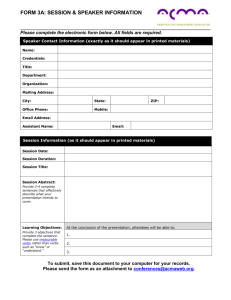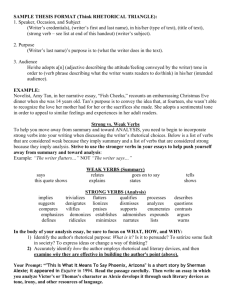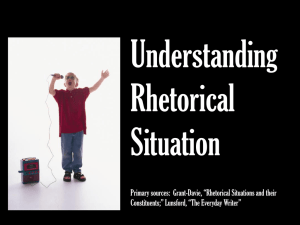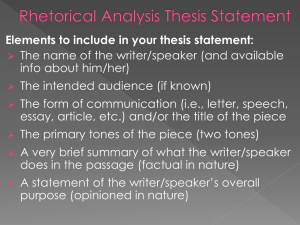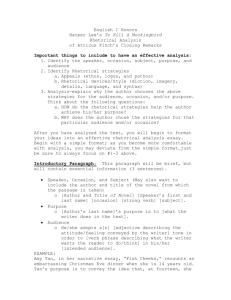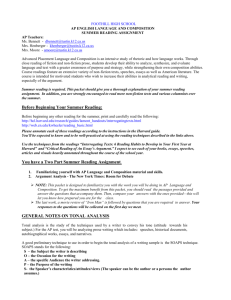MAKE-UP WORK FOR 09/24/12 Regular and AP Classes
advertisement
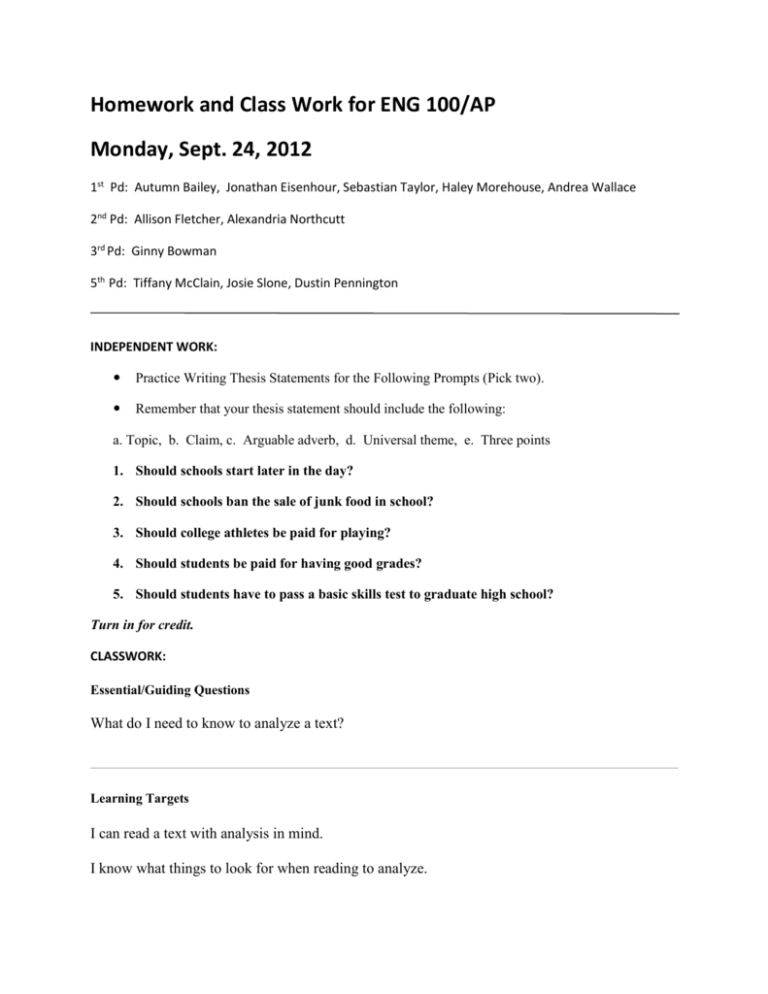
Homework and Class Work for ENG 100/AP Monday, Sept. 24, 2012 1st Pd: Autumn Bailey, Jonathan Eisenhour, Sebastian Taylor, Haley Morehouse, Andrea Wallace 2nd Pd: Allison Fletcher, Alexandria Northcutt 3rd Pd: Ginny Bowman 5th Pd: Tiffany McClain, Josie Slone, Dustin Pennington INDEPENDENT WORK: Practice Writing Thesis Statements for the Following Prompts (Pick two). Remember that your thesis statement should include the following: a. Topic, b. Claim, c. Arguable adverb, d. Universal theme, e. Three points 1. Should schools start later in the day? 2. Should schools ban the sale of junk food in school? 3. Should college athletes be paid for playing? 4. Should students be paid for having good grades? 5. Should students have to pass a basic skills test to graduate high school? Turn in for credit. CLASSWORK: Essential/Guiding Questions What do I need to know to analyze a text? Learning Targets I can read a text with analysis in mind. I know what things to look for when reading to analyze. Lecture: Things You Must Know in Order to Accurately Analyze a a. SOAPS= Speaker, Occasion, Audience, Purpose, Subject b. Speaker - The speaker is the writer or the person who is putting the message out there. You need to know the speaker's full name and his or her credentials. What can knowing these credentials tell you? What is the purpose of putting this information in your paper? This info plays into the writer's ethos (authority and credibility). It can also help your ethos as a writer and can give you insight info the author's purpose, motives, etc. c. Occasion - When was the piece written? Where was it published? What is the context or situation that surrounds or affects this argument? What can you learn from this information? This info can give you insight into the author's motives and who the audience is. Also, knowing the context can give you info about the currency of the piece and the tone of the writer. d. Audience - Who is the speaker's intended audience? Where do you find this information? It may not come right out and say it, so how do you figure it out? You can look at the publisher and the kind of publication it appeared in. You can look at the occasion. You can look at the tone the author takes or how the author goes about presenting the information. You are looking for clues as you read. You still may not know for sure, but you can make an educated guess. e. Purpose - What is the speaker trying to do with this argument? How do you know this? f. Subject - What is this argument about? What is the overall topic? Record the SOAPS for “The Language Police” to be used in the next activity. AP students, record the SOAPS for the argument you are using for your rhetorical analysis paper. g. How can I use SOAPS in my introduction? The introductory paragraph in an analysis essay is usually brief. However is MUST contain some essential information. This information comes from your analysis of SOAPS. It should take this format: 1. Speaker, Occasion Subject (Writer's Credentials), (Writer's first and last name), in his/her (Type of Text), (Title of Text), (strong verb) (writer's subject). To help you move away from summary and toward ANALYSIS, you need to begin to incorporate strong verbs into your writing when discussing the writer's rhetorical choices. Discuss strong verbs vs. weak verbs. What is the effect of the strong verbs as opposed to the weak ones? See handout for future use. 2. Purpose (Writer's Last Name)'s purpose is to (What the writer does in the text). 3. Audience He/she adopts (or equivalent verb) a(n) (adjective describing the attitude/feeling conveyed by the writer) tone in order to (verb phrase describing what the writer wants readers to do/think) in his/her (intended audience). h. Example: Novelist, Amy Tan, in her narrative essay, “Fish Cheeks,” recounts an embarrassing Christmas Eve dinner when she was 14 years old. Tan’s purpose is to convey the idea that, at fourteen, she wasn’t able to recognize the love her mother had for her or the sacrifices she made. She adopts a sentimental tone in order to appeal to similar feelings and experiences in her adult readers. i. Use your notes and the above example to write the intro for "The Language Police." We will be discussing Tone later in the week. For now leave a blank or space for the adjective describing the tone in your intro. (AP students, write the background portion of your rhetorical analysis paper, instead of “The Language Police.” NOTE: Your introduction should begin with an attention getter, followed by background info (this part) and then concluded by the thesis statement. This is the middle section of your intro. j. Turn in for credit. (AP students, hold on to this. You will be turning it it on Monday, Oct. 1 as a part of your first draft.) ENG 100 STRONG VERBS VS. WEAK VERBS WEAK VERBS (SUMMARY) Says Relates Goes on to say Tells This quote shows Explains States Shows STRONG VERBS (ANALYSIS) Implies Demonizes Dismisses Lists Suggests Ridicules Supports Describes Compares Flatters Admonishes Questions Emphasizes Lionizes Narrates Contrasts Defines Praises Processes Argues Trivializes Establishes Analyzes Warns Denigrates Minimizes Enumerates Vilifies Qualifies Expounds POWERFUL AND MEANINGFUL VERBS TO USE IN YOUR ANALYSIS ALTERNATIVES TO “SHOW” Acknowledge Characterize Correct Determine Employ Address Claim Create Differentiate Enable Analyze Clarify Convince Disagree Engage Apply Compare Critique Discard Enhance Argue Complicate Declare Discover Establish Assert Confine Deduce Discus Evaluate Augment Connect Defend Distinguish Exacerbate Broaden Consider Demonstrate Duplicate Examine Calculate Construct Deny Elaborate Exclude Capitalize Contradict Describe Emphasize Exhibit Expand Instigate Persist Repair Vary Explain Integrate Point out Report View Exploit Interpret Possess Represent Vindicate Express Intervene Predict Resolve Yield Extend Invert Present Retrieve Facilitate Isolate Prove Reveal Feature Justify Produce Revise Forecast Locate Promote Separate Formulate Loosen Propose Shape Fracture Maintain Prove Signify Generalize Manifest Provide Simulate Group Manipulate Qualify Solve Guide Measure Quantify Specify Hamper Merge Question Structure Hypothesize Minimize Realize Suggest Identify Modify Recommend Summarize Illuminate Monitor Reconstruct Support Illustrate Necessitate Redefine Suspend Impair Negate Reduce Sustain Implement Nullify Refer Tailor Implicate Obscure Reference Terminate Imply Observe Refine Testify Improve Obtain Reflect Theorize Include Offer Refute Translate Incorporate Omit Regard Undermine Indicate Optimize Reject Understand Induce Organize Relate Unify Initiate Outline Rely Utilize Inquire Overstate Remove Validate
